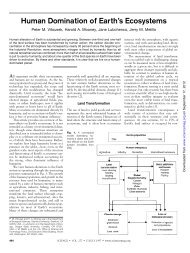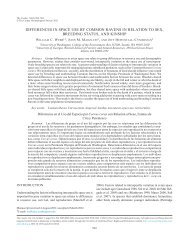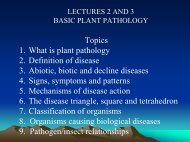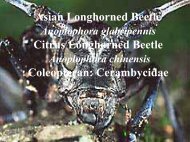Create successful ePaper yourself
Turn your PDF publications into a flip-book with our unique Google optimized e-Paper software.
Ch14 10/5/99 2:19 PM Page 348<br />
348 CHAPTER 14<br />
Several species of fungi also cause galls. For example, Phomopsis spp. causes<br />
globose galls on oaks, hickories, maples, and American elm that are similar to<br />
crown gall. Macrophoma tumefaciens causes almost spherical galls on poplars in<br />
the Rocky Mountains and Lake states.<br />
DECAY<br />
Figure 14.8<br />
Bacterial gall on Douglas-fir.<br />
(Source: From Scharpf 1993.)<br />
Wood decay is the decomposition of wood by the enzymatic activities of microbes,<br />
primarily fungi (Manion 1991). Bacteria can decompose wood, but are inefficient<br />
compared to fungi. Insects, marine organisms, and UV light also can deteriorate<br />
wood.<br />
Knowledge of wood chemistry is extremely important in understanding the<br />
decay process. Wood consists primarily of cellulose, hemicellulose, lignin, and<br />
extractives. Cellulose, hemicellulose, and lignin are the major constituents of cell<br />
walls, whereas extractives are not in the cell wall and typically confer decay resistance.<br />
Extractives are primarily phenolic chemicals. Species, such as western redcedar,<br />
redwood, and Douglas-fir, with colored heartwood typically have a high<br />
extractive content and have higher decay resistance than species with white heartwood<br />
such as hemlocks, spruces, and true firs.<br />
Types of Decay<br />
There are three basic types of decay: white, brown, and soft rot (Boyce 1961) as<br />
shown in Box 14.1.<br />
White rots are fibrous because some cellulose remains intact until late in the<br />
decay process. It is whitish because of the loss of lignin, which is brown, and<br />
because the remaining cellulose tends to be white. Cellulose is degraded by a complex<br />
of enzymes known as cellulases, which typically break the cellulose into<br />
shorter chains and eventually into glucose, the building block of cellulose. White

















